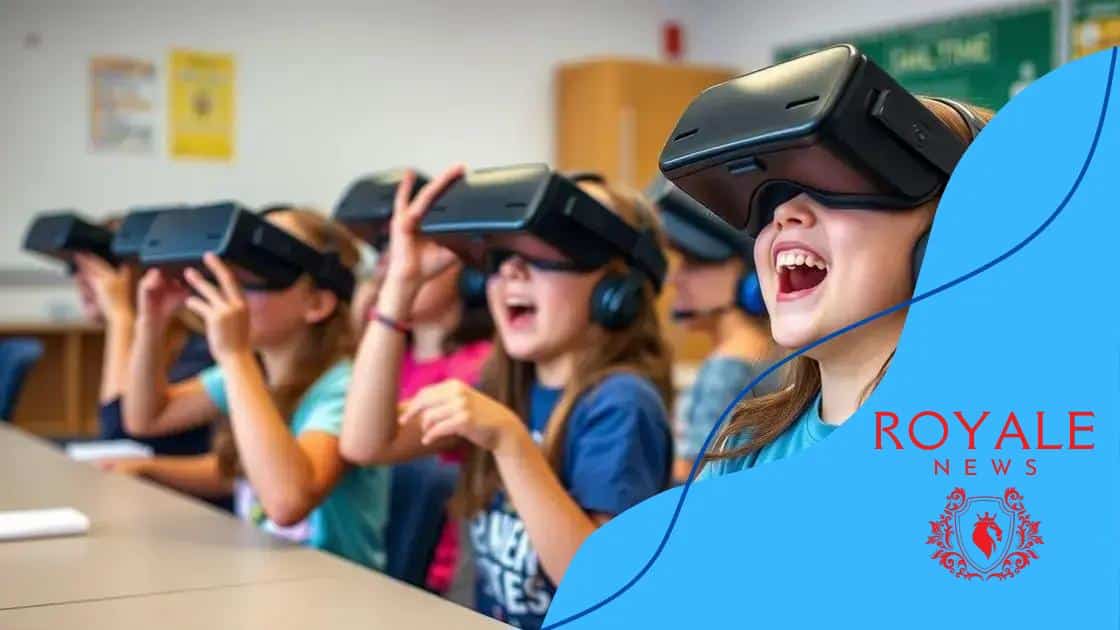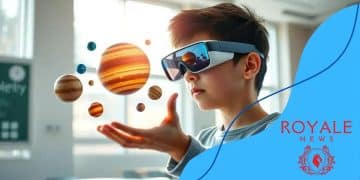Virtual reality enhancing remote education experience

Virtual reality enhancing remote education significantly improves student engagement through immersive experiences, real-world simulations, and tailored curriculum integration, despite challenges like cost and accessibility.
Virtual reality enhancing remote education is changing the way we think about learning. Imagine stepping into a virtual classroom where geography comes alive or historical events unfold right before your eyes. Curious about how this technology is reshaping education? Let’s dive in!
Understanding virtual reality in education
Understanding virtual reality in education is essential for grasping how it can transform the learning experience. It enables students to engage with material in a way that is both interactive and immersive.
What is Virtual Reality?
Virtual reality (VR) is a technology that lets users experience computer-generated environments as if they are real. This can include simulations of physical locations or entirely fictional worlds. In education, VR is particularly powerful because it allows students to explore subjects in three dimensions.
Benefits of Virtual Reality in Education
Using virtual reality brings many advantages to remote education. Here are a few:
- Increased engagement and motivation to learn.
- Realistic simulations that enhance understanding.
- Opportunities to explore complex concepts easily.
- Safe environments to practice skills without real-world consequences.
With these benefits, the potential for VR in education becomes clear. For instance, students can take a virtual field trip to ancient Rome or dive into the ocean to study marine biology. These unique experiences can help to retain information much better than traditional methods.
Moreover, virtual reality fosters collaboration among students. Tools allow multiple users to participate in a shared virtual space. This collaboration encourages communication and teamwork, skills essential for both academic and professional success.
Challenges of Implementing VR
While the advantages are significant, some challenges exist in implementing virtual reality in educational contexts. First, the cost of technology can be a barrier for many educational institutions. Additionally, training teachers to effectively use VR tools is necessary and can require significant investment in time and resources.
Despite these challenges, educators are finding creative ways to incorporate virtual reality into their teaching strategies. From using low-cost mobile VR options to partnering with tech companies, the journey toward immersive education is well underway.
Benefits of virtual reality for remote learners
The benefits of virtual reality for remote learners are numerous and impactful. By immersing students in a digital learning environment, VR can enhance their educational experience, making it more effective and engaging.
Enhanced Engagement
One of the primary benefits is increased student engagement. When learners can experience lessons in a virtual space, they are more likely to stay focused and interested. This immersive approach captivates their attention compared to traditional online methods.
Real-World Simulations
Virtual reality allows students to encounter real-world scenarios in a controlled setting. This experience is particularly valuable in fields such as medicine, engineering, and environmental science. For instance, medical students can practice surgeries virtually, improving both their skills and their confidence.
Access to Unique Experiences
Furthermore, VR provides access to educational experiences that may not be possible otherwise. Students can explore the depths of the ocean or journey through space without leaving their homes. This ability to explore unique environments greatly enriches their learning.
- Students can visit historical sites and gain insights into different cultures.
- They can conduct virtual science experiments that would be unsafe or impractical in real life.
- This technology accommodates various learning styles, catering to visual and kinesthetic learners.
Additionally, virtual reality promotes collaboration among remote learners. Students can join peers in shared virtual experiences, fostering teamwork and communication skills. These shared moments can create bonds similar to those formed in physical classrooms.
Alongside these advantages, the use of virtual reality can lead to improved retention of information. Studies show that immersive learning helps students remember content longer. By engaging multiple senses, VR reinforces learning in a way that traditional methods often fail to achieve.
How virtual reality can improve student engagement

How virtual reality can improve student engagement is a key point for educators looking to enhance the learning experience. By creating an immersive learning environment, VR captures students’ attention in ways that traditional methods may not.
Immersive Learning Experiences
Virtual reality offers immersive experiences that allow students to participate actively in their learning. Instead of just reading about historical events or scientific concepts, they can explore these subjects in a virtual environment. This active participation promotes deeper understanding.
Gamification of Learning
Another way that VR enhances student engagement is through gamification. Many virtual reality applications are designed like games, making learning fun and motivating. When students interact in a game-like setting, they are more likely to stay engaged and excited about learning.
- Friendly competition can motivate students to better their skills.
- Experience-driven learning encourages trial and error without the fear of failure.
- Rewards and achievements recognize student progress, boosting confidence.
Furthermore, virtual reality brings lessons to life by simulating real-world applications. Imagine a lesson on ecosystems where students can walk through a rainforest or dive into a coral reef. These experiences not only engage learners but also allow them to connect their studies to practical scenarios, enhancing relevance.
Collaborative experiences in VR also increase engagement. Students working together in a virtual setting can communicate and problem-solve as a team, building important social skills while learning content. This collaborative aspect mimics real-world situations where teamwork is essential.
Addressing Different Learning Styles
By catering to various learning styles, virtual reality can engage students more effectively. Visual learners benefit from the striking graphics, while kinesthetic learners gain hands-on experience in a risk-free space. This flexibility means that more students can find success in their learning.
Implementing virtual reality in educational programs
Implementing virtual reality in educational programs can greatly enhance the learning experience. It allows educators to utilize advanced technology to engage and motivate students in new ways.
Choosing the Right Technology
The first step in implementing virtual reality is selecting the appropriate devices and software. There are many options available, ranging from high-end systems to affordable mobile applications.
Developing a Curriculum
Incorporating VR into the curriculum requires careful planning. Teachers should determine how to align VR experiences with educational goals. For instance, using VR to simulate historical events can enrich the learning of history.
- Identify subjects that will benefit from immersive experiences.
- Create lesson plans that integrate VR activities.
- Train teachers on how to use VR tools effectively.
Another important aspect is to ensure that the technology is accessible to all students. This can involve providing headsets and ensuring reliable internet access. The goal is to create an inclusive environment where every student can participate in virtual reality lessons.
Collaboration with IT departments is also important. They can help manage the technical aspects of VR, ensuring that everything runs smoothly during lessons. Regular support and maintenance are vital to keep the VR tools functioning properly.
Monitoring and Assessing Impact
Once virtual reality is implemented, it is essential to monitor its effectiveness. Teachers should assess how VR impacts student engagement and learning outcomes. Surveys and feedback from students can provide valuable insights.
Teachers might also consider adjusting their methods based on what they learn. This adaptability can help refine VR integration and maximize its benefits for students.
Challenges and solutions for using virtual reality
Challenges and solutions for using virtual reality in education are important to address for effective implementation. While VR offers exciting opportunities, several obstacles can hinder its success.
Cost of Technology
One major challenge is the cost associated with acquiring and maintaining virtual reality technology. High-quality VR headsets and software can be expensive, making it difficult for schools to adopt these tools. To combat this issue, schools can explore partnerships with technology companies or seek grants specifically for educational technology.
Technical Support
Another challenge is the need for technical support. Many educators may feel overwhelmed by the technology or lack the skills to troubleshoot issues. Providing training sessions for teachers can empower them to use virtual reality effectively. Schools can also establish support teams that are readily available to assist with technical difficulties.
Limited Content
The availability of engaging content can also pose a challenge. While there are some educational VR applications, the range is still limited compared to traditional materials. Developers and educators should work together to create a variety of interactive content that aligns with curriculum standards, ensuring that students benefit from immersive experiences.
- Encourage collaboration among educators to share successful VR lesson plans.
- Invest in developing custom VR experiences tailored to specific subjects.
- Utilize open-source platforms to create accessible content.
An additional challenge is ensuring that all students can access and benefit from virtual reality. Not everyone has the same level of access to technology at home. Schools could set up dedicated VR labs or allocate time for students to use VR technology during school hours to promote equity in learning experiences.
Health and Safety Considerations
Health and safety are also concerns associated with using VR. Some students may experience motion sickness or discomfort when using headsets for extended periods. To address this, teachers should limit VR sessions and provide breaks. It’s also vital to educate students on using VR safely, ensuring they are aware of their surroundings while immersed in virtual environments.
virtual reality in education holds immense potential to transform the learning experience. Despite the challenges like cost and limited content, educators can find innovative solutions to enhance student engagement and participation. By carefully selecting technology, developing a tailored curriculum, and providing the necessary support, schools can create an engaging and inclusive learning environment. The advantages of VR, including immersive experiences and real-world simulations, can significantly benefit students and prepare them for a future where technology plays a key role in education and beyond.
FAQ – Frequently Asked Questions about Virtual Reality in Education
What are the main benefits of using virtual reality in education?
Virtual reality enhances student engagement by providing immersive learning experiences and real-world simulations, making lessons more interactive.
What challenges do schools face when implementing virtual reality?
Challenges include high costs, the need for technical support, limited content, and ensuring equitable access for all students.
How can teachers effectively use virtual reality in their lessons?
Teachers can create lesson plans that integrate VR activities, provide training for using the technology, and collaborate with others to share successful practices.
Is virtual reality accessible for all students?
While some students may lack access to VR technology at home, schools can set up dedicated VR labs and allocate time during school hours for all students to participate.





